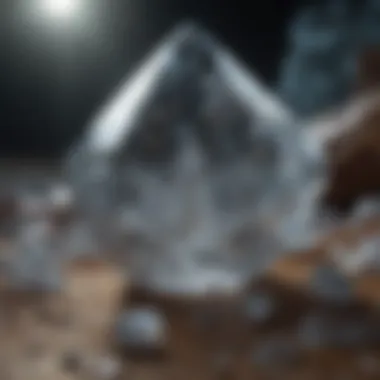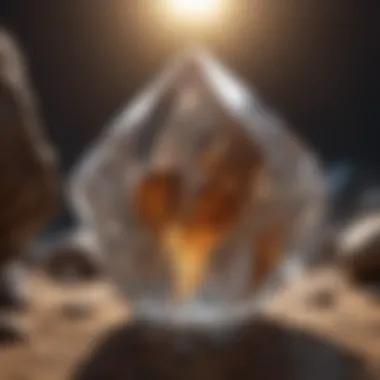Unraveling the Intricate World of Mineral Crystals: A Comprehensive Guide


Rock and Fossil Identification
In the realm of mineral crystals, understanding rock and fossil identification is paramount. Delving into the intricate world of these geological marvels requires a keen eye for detail and an appreciation for the unique characteristics that define each specimen. Types of rocks and fossils vary widely, ranging from igneous to sedimentary formations, each with its own distinct features and formation processes. As a meticulous collector or enthusiast, it is essential to be well-versed in the characteristics to look for when identifying mineral crystals. This includes texture, color, crystal structure, and any unique inclusions that set specimens apart from others. Utilizing specialized tools for identification, such as loupes, UV lights, and hardness testing kits, enhances the precision and accuracy of the identification process, allowing for a more thorough exploration of these geological treasures.
Introduction to Mineral Crystals
In this article, we embark on a captivating journey into the mesmerizing realm of mineral crystals, exploring their wondrous formations and unique characteristics. As avid collectors and enthusiasts seek a deeper understanding of these geological marvels, the importance of delving into the world of mineral crystals cannot be overstated. By unveiling the intricate details of mineral crystals, we aim to provide a comprehensive guide that sheds light on their profound allure and significance in the geological world.
Understanding the Formation Process
The Role of Pressure and Temperature
The formation of mineral crystals is a complex process influenced significantly by the role of pressure and temperature. These two crucial factors play a pivotal role in determining the crystal structure and composition. Pressure and temperature not only affect the rate of crystal growth but also impact the overall quality and clarity of the crystals. By understanding how pressure and temperature interact during the crystallization process, collectors and enthusiasts can gain insights into the environmental conditions that give rise to diverse mineral formations.
Crystal Growth Mechanisms
Crystal growth mechanisms elucidate the intricate processes through which minerals develop their distinct shapes and structures. From nucleation to crystal growth, various mechanisms come into play, shaping the final crystal form. Understanding these mechanisms provides valuable information about the environmental conditions under which crystals form and grow. By delving into the world of crystal growth mechanisms, collectors can appreciate the intricate beauty and complexity inherent in mineral crystallization.
Types of Mineral Crystals
Silicate Minerals
Silicate minerals represent a diverse and abundant group of minerals that form the building blocks of most rocks on Earth. Their unique composition of silicon and oxygen gives rise to a wide range of crystal structures, each with its own set of physical and chemical properties. Silicate minerals are renowned for their resilience and versatility, making them a popular choice among collectors and researchers alike.
Carbonate Minerals
Carbonate minerals, characterized by the presence of carbonate ion (CO3) groups, encompass a variety of minerals with distinct crystal structures and properties. From calcite to aragonite, carbonate minerals exhibit remarkable diversity in color, transparency, and crystal habit. Collectors are drawn to carbonate minerals for their exquisite beauty and unique geological significance.
Sulfate Minerals
Sulfate minerals, composed of sulfate ion (SO4) groups, are renowned for their diverse crystal forms and vivid colors. From gypsum to barite, sulfate minerals showcase an array of physical properties that make them valuable additions to any mineral collection. Their presence in various geological formations highlights the dynamic processes that shape our planet's mineral diversity.


Physical Properties
Color and Transparency
The color and transparency of mineral crystals offer valuable insights into their chemical composition and formation history. Whether opaque or transparent, colored or colorless, these physical properties provide clues about the presence of impurities and trace elements within the crystal structure. By examining color and transparency, collectors can discern subtle variations in crystalline characteristics and appreciate the beauty of nature's infinite manifestations.
Crystal Habit and Cleavage
Crystal habit and cleavage describe the external shape and internal structure of mineral crystals, providing essential information on their formation processes. The specific arrangement of atoms and molecules within a crystal dictates its habit and cleavage properties, influencing its overall appearance and durability. Understanding crystal habit and cleavage enhances collectors' ability to identify and classify minerals based on their structural features, enriching their appreciation for the intricate world of mineral crystals.
Crystallography and Symmetry
Crystallography and Symmetry play a central role in unraveling the complex nature of mineral crystals. Understanding crystallography provides invaluable insights into the atomic arrangement and structural composition of crystals. The symmetry elements within crystals dictate their external forms and internal arrangements, shedding light on their properties and behavior. By delving into crystallography and symmetry, we gain a deeper appreciation for the geometric precision and symmetrical patterns inherent in mineral crystals.
Symmetry Elements in Crystals
Mirror planes
Mirror planes serve as pivotal symmetry elements within crystals, reflecting the structure across a specific plane. This symmetry property contributes significantly to understanding crystal symmetry and patterning. The key characteristic of mirror planes lies in their ability to generate mirrored reflections, offering insights into the internal symmetry of crystals. This choice to focus on mirror planes in the article stems from their fundamental role in crystallography studies. The unique feature of mirror planes is their capacity to reveal various symmetry operators and mirror operations, enhancing the comprehension of crystal symmetry. Despite their advantages in elucidating crystal structures, mirror planes may present challenges in complex crystal systems due to overlapping reflections and intricate arrangements.
Rotational axes
Rotational axes act as vital symmetry elements, highlighting the rotational symmetry present within crystals. The key characteristic of rotational axes is their role in generating symmetry operations through rotational movements. This aspect is crucial for identifying the rotational symmetry inherent in crystal structures. The choice to explore rotational axes in this context is driven by their significance in depicting crystal symmetry in a comprehensive manner. The unique feature of rotational axes lies in their ability to showcase rotational symmetry operations with varying degrees and axes. While rotational axes prove beneficial in illustrating crystal symmetry principles, they may pose limitations in characterizing asymmetric crystal forms that lack rotational symmetry. Understanding both mirror planes and rotational axes enriches our comprehension of crystal symmetry and aids in deciphering the intricate arrangements within mineral crystals.
Crystal Systems
Hexagonal
The hexagonal crystal system exhibits distinctive properties contributing to the overall understanding of crystallography. Its key characteristic lies in the presence of a six-fold rotational symmetry axis, reflecting a high degree of internal symmetry within hexagonal crystals. The choice to delve into hexagonal crystal systems in this article arises from their widespread occurrence in nature and significance in crystallography studies. The unique feature of hexagonal crystals is their hexagonal prism shape and symmetry operations aligning with the six-fold rotational axis, offering clarity in crystallographic analysis. While hexagonal crystal systems prove beneficial in elucidating specific crystal structures, their disadvantage lies in constraints related to growth patterns and limitations in symmetry operations beyond six-fold axes.
Tetragonal


The tetragonal crystal system showcases specific attributes contributing to a comprehensive understanding of crystallography principles. Its key characteristic involves the presence of a four-fold rotational symmetry axis, denoting a distinct internal symmetry within tetragonal crystals. The decision to discuss tetragonal crystal systems in this context is motivated by their prevalence in mineral crystals and relevance in crystallography studies. The unique feature of tetragonal crystals lies in their square prism structure and symmetry operations aligned with the four-fold rotational axis, facilitating detailed crystallographic examinations. While tetragonal crystal systems assist in elucidating crystal symmetry aspects, their disadvantage lies in constraints related to crystal growth tendencies and limitations in symmetry beyond four-fold rotational axes.
Orthorhombic
The orthorhombic crystal system demonstrates specific characteristics instrumental in advancing crystallography knowledge. Its key attribute lies in the absence of rotational symmetry axes beyond three-fold axes, indicating a diverse range of internal symmetries within orthorhombic crystals. The choice to highlight orthorhombic crystal systems in this article is driven by their prevalence in mineral formations and their significance in crystallography investigations. The unique feature of orthorhombic crystals is their orthogonal prism shape and absence of higher rotational symmetry axes, providing insights into unique crystallographic arrangements. While orthorhombic crystal systems aid in elucidating complex crystal structures, their limitation lies in challenges related to interpreting crystallographic data without higher rotational symmetry axes.
Miller Indices
Defining crystallographic planes
The Miller indices serve as a crucial aspect in crystallography, offering a systematic approach to defining crystallographic planes within mineral crystals. The key characteristic of Miller indices lies in their ability to represent crystal planes through rational numbers, simplifying the notation of crystallographic directions and planes. This choice to focus on defining crystallographic planes using Miller indices in the article stems from their utility in crystallography studies as a standardized notation system. The unique feature of Miller indices is their capacity to delineate crystal planes with precision, enabling accurate communication of crystallographic data. While Miller indices prove advantageous in crystallographic analysis, they may present challenges in interpreting complex crystal structures with intersecting planes and intricate orientations. Delving into the intricacies of Miller indices enriches our understanding of crystallography principles and aids in deciphering the geometric arrangements within mineral crystals.
Chemical Composition and Diversity
Diving into the intricate world of mineral crystals entails unravelling the captivating realm of chemical composition and diversity, which plays a pivotal role in shaping their unique properties and characteristics. Understanding the chemical composition of minerals is essential for discerning collectors and enthusiasts seeking to explore the vast array of crystalline structures. The diversity present in mineral compositions offers a plethora of variations, each showcasing distinct features that contribute to the allure of mineral crystals.
Common Minerals and Elements
Quartz and its Variations
Exploring the realm of mineral crystals leads us to Quartz and its versatile variations, which stand out prominently in the world of geology. Quartz, known for its pervasive presence in various geological formations, boasts exceptional clarity and durability, making it a highly sought-after mineral species among collectors. The key characteristic of Quartz lies in its hexagonal crystal structure, presenting a unique blend of aesthetics and resilience. Particularly renowned for its thermodynamic stability, Quartz varieties such as Amethyst and Citrine exhibit striking colors and compositions that add depth to mineral collections. The abundance and diversity of Quartz variants make them indispensable in geological studies and aesthetic pursuits, elevating their significance in this article.
Calcite and Aragonite
In the realm of mineralogy, Calcite and Aragonite emerge as fundamental mineral stalwarts with distinct characteristics that enrich the landscape of crystal formations. Calcite, renowned for its rhombohedral cleavage and vibrant colors, holds a prominent place in mineral collections due to its widespread occurrence and optical properties. Aragonite, a polymorph of Calcite, exhibits unique crystal habits and structural differences that intrigue collectors and researchers alike. The intricate features of Calcite and Aragonite, ranging from their varied crystal forms to their diverse origins, offer a wealth of information for enthusiasts delving into the world of mineral crystals. Their differential properties and contributions to geological processes underscore their significance in elucidating the complexities of mineral compositions.
Trace Elements and Coloration
Unveiling the complexities of mineral crystals entails a thorough exploration of trace elements and their profound effects on the coloration and characteristics of crystals. The presence of trace elements, commonly in the form of impurities, imparts distinct hues and properties to minerals, influencing their aesthetic appeal and structural integrity. Delving into the realm of impurities reveals a nuanced narrative of how hidden elements can alter the visual aspects and physical attributes of crystals. Understanding the role of impurities and their consequential effects enriches the study of mineral crystals, offering enthusiasts a deeper insight into the intricate interplay between composition and coloration.
Impurities and Their Effects


Examining the impact of impurities uncovers a fascinating array of influences that shape the appearance and properties of mineral crystals. Impurities, whether intentional or incidental, affect the optical properties and structural composition of crystals, giving rise to a diverse spectrum of colors and patterns. The key characteristic of impurities lies in their ability to modulate the behavior of minerals, leading to variations in clarity, hardness, and refractive indices. By dissecting the effects of impurities on crystal formation and growth, collectors and researchers can discern the subtle nuances that define the unique allure of each mineral specimen. The exploration of impurities opens a gateway to understanding the intricate dance between trace elements and coloration, shedding light on the hidden intricacies embedded within the crystalline structures.
Crystal Growth and Forms
Crystal growth and forms play a crucial role in understanding the complexities of mineral crystals outlined in this article. By delving into the specifics of crystal growth and forms, enthusiasts and collectors alike can gain invaluable insights into the intricacies of how minerals evolve and develop their unique structures. Exploring the nuances of crystal growth and forms allows for a deeper appreciation of the beauty and diversity within the world of mineralogy. With a focus on key elements such as nucleation, growth patterns, and faceting, this section sheds light on the foundational processes that shape mineral crystals.
Nucleation and Growth
Stages of crystal formation
Stages of crystal formation serve as a pivotal aspect within the study of mineral crystallization, contributing significantly to the overall understanding of crystal growth and development. The progression from nucleation to the growth of well-defined crystal faces highlights the transformative journey minerals undergo in their formation process. The distinct stages of crystal formation delineate key transitional phases, presenting a template for the crystalline structure to follow. Understanding these stages is fundamental in grasping the complexities of crystal growth, offering valuable insights into the mechanisms governing mineral crystal development in various geological settings. The elucidation of these stages provides a comprehensive framework for analyzing crystal growth patterns, contributing to the overarching goals of this article by showcasing the intricate nature of mineral crystal formation and evolution.
Crystal Faces and Terminations
Facet development
Facet development plays a pivotal role in shaping the outward appearance of mineral crystals, contributing significantly to their visual appeal and structural integrity. The unique characteristics of facet development, including symmetry, surface features, and termination patterns, offer valuable information about the growth history and environmental conditions experienced by mineral crystals. By highlighting the importance of facet development, this section provides a detailed analysis of how external influences impact crystal growth and morphology. Examining the facets of mineral crystals allows for a deeper understanding of their inherent beauty and the mineralogical processes that govern their formation. Through a nuanced exploration of facet development, readers can gain a comprehensive understanding of the intricate relationships between crystal faces, terminations, and crystallographic principles.
Habit Modification
External influences
External influences exert a substantial impact on the habit modification of mineral crystals, shaping their growth patterns and structural characteristics. By delving into the specific aspects of external influences, this section illuminates the role of environmental factors in molding the habits and forms of mineral crystals. The key characteristics of external influences, including temperature fluctuations, chemical compositions, and pressure variations, underscore the dynamic interplay between nature and crystal development. Understanding how external influences modify crystal habits enhances the reader's perception of the adaptability and resilience of mineral crystals in response to changing geological conditions. By examining the unique features of external influences, readers can appreciate the intricate relationships between environmental factors and the ultimate form taken on by mineral crystals, underscoring the dynamic nature of crystal growth and evolution.
Unique Characteristics and Inclusions
Mineral crystals are renowned for their unique characteristics and inclusions, which play a crucial role in understanding their formation and history. These features provide valuable insights into the geological processes that shaped them over time, making them essential components of mineralogical research and collection. By examining the distinct properties of crystals, such as twinning and pseudomorphism, collectors and enthusiasts can unravel the intricate stories these specimens hold within their structures. Moreover, studying inclusions trapped within crystals offers scientists a window into past environments and chemical compositions, shedding light on the conditions under which these minerals originated. In this article, we delve deep into the significance of unique characteristics and inclusions, offering readers a comprehensive exploration of these captivating facets of mineral crystals.
Twinning and Pseudomorphism
Reconstructing crystal growth
Twinning and pseudomorphism are two fascinating phenomena within the realm of mineral crystals that intrigue researchers and collectors alike. Reconstructing crystal growth involves understanding how crystals can combine to form intricate patterns and structures, resulting in visually striking specimens. The ability to identify and interpret these growth patterns enhances our knowledge of mineral formation processes and mineralogical properties. This aspect contributes significantly to the overall understanding of crystallography, shape determination, and geological history. The unique feature of reconstructing crystal growth lies in its capacity to reveal complex relationships between crystal structures and environmental conditions, providing valuable information for geological reconstructions and crystal identification. While this topic requires meticulous attention to detail and analytical skills, its inclusion in this article serves to illuminate the complexity and beauty of crystal growth mechanisms, enriching readers' understanding of mineral crystal development.
Inclusions and Their Significance
Trapped minerals and gases encapsulated within crystal structures offer a treasure trove of information for researchers and collectors interested in unraveling the mysteries of mineral origins and evolution. By studying inclusions, scientists can identify rare mineral phases, trace elemental compositions, and even detect ancient microbial life preserved within crystals. The key characteristic of inclusions lies in their ability to act as time capsules, preserving snapshots of the geological past within their mineral hosts. This feature makes trapped minerals and gases a popular choice for inclusion in this article as it highlights the scientific and historical significance of these tiny encapsulated worlds. The unique feature of inclusions unveils a hidden world of mineralogical wonders, showcasing the diverse range of materials and environments that contribute to the formation of mineral crystals. As readers embark on a journey of exploration through these inclusions, they will gain a deeper appreciation for the intricate details and fascinating stories hidden within the crystalline structures they admire.







